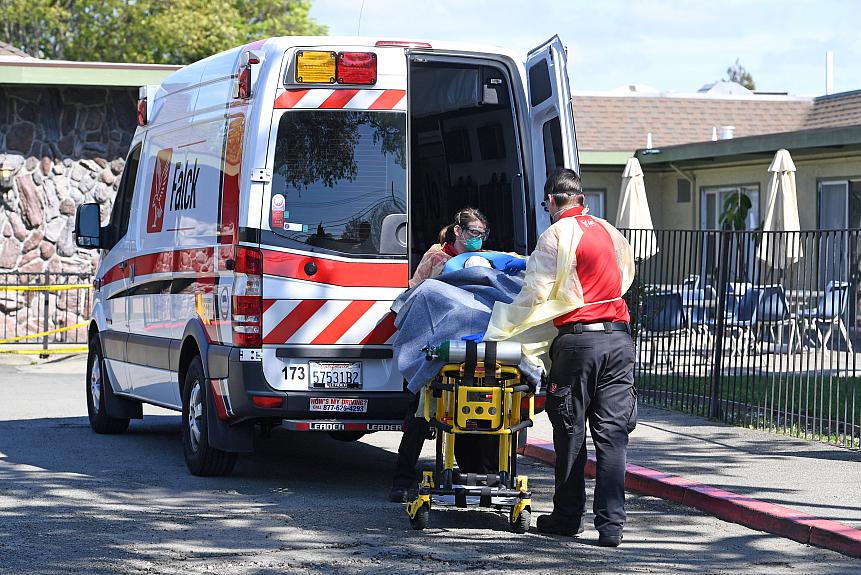The coronavirus pandemic devastated nursing homes. What needs to change?

A senior is transferred into a nursing home in Hayward, California on April 10, 2020.
(Photo: Doug Duran/Bay Area News Group.
There’s no question that the coronavirus pandemic has hit the Golden State’s seniors hard. Californians age 65 and up make up just 15.6% of the state’s overall population, but state data indicates they account for 74% of coronavirus-related deaths. The statistics are even more stark for the very oldest residents — those 80 and up. That group makes up less than 4% of the population but accounts for nearly 40% of fatalities linked to COVID-19.
Those living in group settings have been particularly hard hit. Social distancing in group settings, particularly in memory care facilities where Alzheimer’s disease and dementia are common, is difficult to enforce. Caregivers, already earning low wages for long, strenuous hours, have been overwhelmed by the demands of the pandemic — work that can quickly become life threatening when the virus invades. According to the American Community Survey, less than 2% of the state’s seniors live in nursing homes, yet nursing homes account for roughly 20% of the state’s pandemic-related deaths. Assisted living facilities, which are much more common, have also been hit hard. People of color have been particularly impacted. A study reported in the Journal of the American Medical Association found that those with the highest proportions of non-white residents experienced death counts that were more than three times those with mostly white residents.
As more seniors and their caregivers receive coronavirus vaccinations and the thousands of facilities and individual families who provide care for seniors begin to emerge from the “crisis mode” of the last year, what will the lasting impact be? Will nursing homes and assisted living facilities alter their protocols or the type of care they offer in the wake of the deadly pandemic?
Already, lawmakers in Sacramento — including Bay Area Assemblyman Ash Kalra — are spearheading new legislation aimed at increasing oversight of corporations that run nursing facilities. Will state lawmakers pass new legislation affecting elder care this year? Will new advocacy organizations form and will those already in existence become more powerful? Will families who might have considered a group living setting for a loved one before the pandemic ultimately decide to seek at-home care instead? Will seniors themselves rethink what they want in their final years? And will paid caretakers — often hourly, low-income people of color with few work benefits who have put their lives at risk for months — receive any new protections?
I plan to pursue a project, to be published by the Bay Area News Group in print and online, focused on how the coronavirus affects elder care in California, with a particular emphasis on seniors from disadvantaged and low-income communities in the Bay Area.
I plan to approach this project for the 2021 California Fellowship from a number of angles, including a comparison of how well-resourced facilities have fared compared to facilities in hard-hit, disadvantaged communities. What works, what doesn’t, and what needs to change? I also intend to analyze public inspection reports that track violations at nursing homes and assisted living facilities and analyze the violations that occurred at places with high death rates, in particular.
Throughout the reporting process, I also intend to speak with Bay Area families that have made or are making elder care decisions, examining the factors that go into those decisions, including everything from cost to cultural considerations. Will there be new efforts to support families opting for in-home care?
Perhaps most importantly, I will highlight the voices of seniors and health care workers themselves. I’ve spoken with geriatricians at UCSF, Stanford and elsewhere during the pandemic who say one of the state’s main failings when it comes to seniors is that officials don’t involve them in decision-making processes and produce one-size-fits-all solutions that leave many seniors behind. I’ll talk to seniors in various living situations about the impact of the pandemic and what they want to see changed moving forward. I’ll also look at efforts by unions and advocacy groups to push for worker benefits and assess whether they have a chance of passing.
The stakes are high. California has an aging population and while the state may not experience another event on the scale of the coronavirus pandemic in our lifetimes, residents will grapple with infectious disease outbreaks in the future. COVID-19 has laid bare the inequities and pitfalls in the current patchwork of care options for seniors and their families, and presents a unique opportunity to spark meaningful reforms that could affect where and how seniors live out their final years for decades to come.

